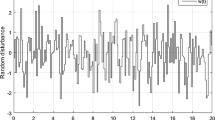Abstract
The Internet backbone of many corporations carries two kinds of traffic: urgent and delayable. Shifting some traffic from peak periods to valleys reduces capacity requirements. We consider the case of managing the delayable traffic by an admission control (AC) system. AC gets link utilization feedback every τ seconds. Delayable opt-in sources obtain permission from AC to transmit for up to τ seconds at a rate not exceeding a limit imposed by AC, renewing permission as needed. Urgent traffic bypasses AC. AC must allocate bandwidth to competing delayable traffic sources. We prove that among all throttling transformations of flows that achieve a desired mean aggregate flow, rate limits on flows minimize the variance of their sum. Furthermore, a single rate limit common to all flows achieves the optimum. Thus, for a single link, AC must decide on a single rate limit for all delayable sources in each τ-second cycle. We evaluate different policies that set the rate limit dynamically in an empirical setting using netflow records on a link on the backbone of Yahoo!. Using historical data, we also derive the best possible reduction in capacity of this link using a closed-form solution to an assignment problem. We show that AC can achieve capacity reduction close to the best possible reduction.







Similar content being viewed by others
Notes
There is much variability in volume and class-ratios across days.
This is reasonable since opt-in controlled sources do not care too much about delays in the discretionary traffic that they send via AC.
Note that AC-negotiated traffic can see delays longer than 10 seconds and therefore capacity reduction can be bigger than in Figure 2.
This pair of parameters is sufficient for AC to transmit almost all class-2 traffic without exceeding the target capacity.
References
Benameur N, Fredj SB, Delcoigne F, Oueslati-Boulahia S, Roberts JW (2001) Integrated admission control for streaming and elastic traffic. Qual Future Internet Serv 2156:69–81
Key P, Massoulie L, Wang B (2004) Emulating lower priority transport at the application layer: a background transfer service. In: Sigmetrics, pp 118–129
Kokku R, Bohra A, Ganguly S, Venkataramani A (2007) A multipath background network architecture. In: Proceedings of IEEE INFOCOM
Kumar A, Hedge M, Anand SVR, Bindu BN, Thirumurthy D, Kherani AA (2000) Nonintrusive tcp connection admission control for bandwidth management of an internet access link. In: IEEE communications magazine, pp 160–167
Kuzmanovic A, Knightly EW (2003) TCP-LP: A distributed algorithm for low priority data transfer. In: Proceedings of IEEE INFOCOM
Sutton RS, Barto AG (1998) Reinforcement learning: an introduction. MIT Press, Cambridge, MA
Tsugawa T, Hasegawa G, Murata M (2006) Background tcp data transfer with inline network measurements. IEICE Trans Commun E89-B No.8:2152–2160
Venkataraman V, Francis P, Kodialam MS, Lakshman TV (2008) A priority-layered approach to transport for high bandwidth-delay product networks. In: ACM CoNEXT, Madrid, Spain
Venkataramani A, Kokku R, Dahlin M (2002) TCP nice: a mechanism for background transfers. In: Proceedings of the 5th symposium on operating systems design and implementation, Boston, MA
Yang S, de Veciana G (2002) Size-based adaptive bandwidth allocation: optimizing the average QoS for elastic flows. In: Proceedings of the 21st annual joint conference of the IEEE computer and communications societies (INFOCOM), pp 657–666
Acknowledgments
We thank Raymie Stata for introducing us to this problem. We thank Adam Bechtel and Igor Gashinsky for constantly educating us about practical constraints in operating a large network.
Author information
Authors and Affiliations
Corresponding author
Rights and permissions
About this article
Cite this article
Langford, J., Li, L., McAfee, P. et al. Cloud control: voluntary admission control for intranet traffic management. Inf Syst E-Bus Manage 10, 295–308 (2012). https://doi.org/10.1007/s10257-011-0166-4
Received:
Revised:
Accepted:
Published:
Issue Date:
DOI: https://doi.org/10.1007/s10257-011-0166-4




